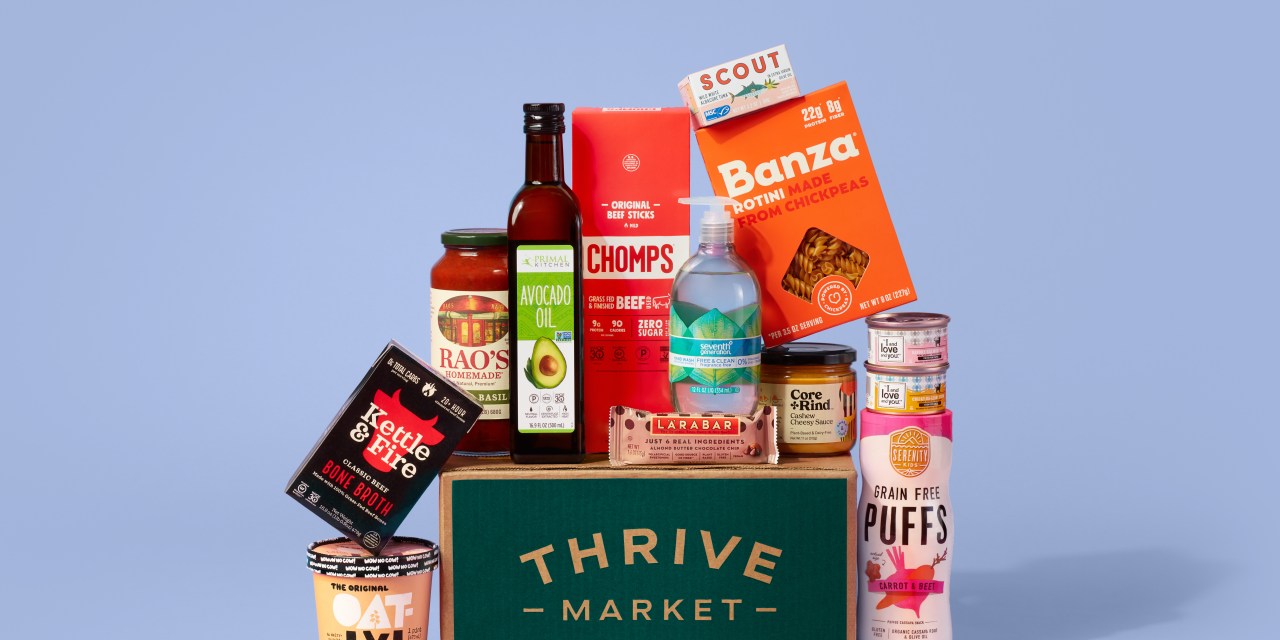Thrive Market begins accepting SNAP benefits on grocery orders

Starting on February 26, Thrive Market will start accepting SNAP benefits in the contiguous United States.
Thrive has 6,000 products on its site, of which 4,000 will be SNAP eligible; Thrive’s offerings range from organic pantry staples to sustainable pasture-raised meat. All EBT cardholders who join Thrive Market as new members will also be eligible for a free membership through the company’s Gives program, which serves families in financial need. The new payment option means more people can shop Thrive Market with their SNAP allowance, creating a new cohort of customers for Thrive Market.
Supplemental Nutritional Assistance Program benefits are increasingly becoming an accepted form of payment across digital grocery stores. Thrive Market co-founder and CEO Nick Green told Modern Retail it’s been a “long road” for the company since it began looking into accepting SNAP in 2015. “It’s been a wild ride but we’re excited to hopefully open the floodgates, in being the first pure-play online retailer to accept food stamps when we go live nationwide,” Green said.
The USDA wants to ensure that digital grocery sites offer a wide assortment of food to EBT cardholders. But that means that online retailers also have to meet a long list of criteria in order to be deemed SNAP eligible. According to the USDA, a retailer’s assortment must cover four staple food categories: Vegetables or fruits, dairy products, Meat, poultry, or fish and Breads or cereals. Furthermore, the retailer must sell a minimum of 36 staple food items that meet the following conditions: three varieties in each of those four food categories, three stocking units for each of the three varieties, and one perishable variety in two of the staple food categories.
In Thrive Market’s case, the company was mostly shipping dry goods like pantry staples up until it added perishable products in 2018, and eventually adding meat and seafood in 2021.
“[The USDA was] also mainly focused on companies with a physical retail presence,” Green said, such as Walmart’s growing grocery delivery service. “Whereas with an online-only store, there were concerns about where the products were stored or the headquarters is located.”
But 2020 was a major turning point, when many Americans began testing out online grocery shopping, Green said. The pandemic indirectly pushed the USDA to accelerate the application process for e-commerce grocery services. After several years of being part of test pilots with the USDA, Thrive received approval to accept SNAP EBT 10 years after the company’s launch.
Green said a big part of the case Thrive Market made with its application is it can offer SNAP cardholders healthy products at an affordable price. The USDA’s criteria emphasize essential ingredients that can be used to cook meals at home. Outside of the retailer’s merchandise, the USDA also considers whether the applicant retailer caters to SNAP recipients that “have very limited access to food.”
There are currently about 42 million Americans that use SNAP’s program, Green noted, with the majority being families that live in health food deserts. “We’re accessing a market of people that’s very different from the typical health food store shoppers in L.A. or New York,” Green said. Currently, 50% of Thrive Market’s paying members are in the Midwest and the Southeast, with the average household income being under $100,000.
Thrive Market operates on a membership model, with members paying $60 a year to get free delivery, among other perks. But, the company also operates the Thrive’s Gives program, which allows people in financial need — include low-income families, teachers, students, first responders and military veterans — to join without paying the membership fee. Through the program, the company has given away two million free memberships to date.
To increase savings for Gives members, the company allows paid members to donate their savings at checkout and pass along lower prices for the Gives members. Green said that Thrive Market already has around 100,000 Gives members on the platform already, out of Thrive’s total membership of 1.4 million.
“The question for us is how to reach those people that we haven’t already gotten on the platform,” Green said. Besides online marketing, the company is looking to spread the word about its SNAP acceptance and reach more low-income families by partnering with nonprofits and organizations that already help SNAP EBT users. Internally, there is a push to promote the offerings on the site and through email to let existing members know they can use SNAP on the site. “We also have a huge network with health and wellness influencers that we partner with, this is a message we want them to really be pushing,” Green said.
One of the biggest hurdles online retailers face when applying to accept SNAP EBT is concerns over fraud and misuse of the benefits, given the shopping is done virtually. As such, companies are working with tech providers like Forage, which build payments infrastructure that processes government benefits, including enabling merchants to accept SNAP EBT payments online.
Josh Trautwein, the co-founder of About Fresh, a Boston-based nonprofit that aims to combat food insecurity, said the widespread acceptance of SNAP among delivery services helps create more options to benefit receivers trying to buy healthier food. “More access means more options for SNAP recipients, something that’s been sorely missing for a long time,” he said. “What we’d love to see as a community is more of a streamlined application and approval process going forward.”
Using SNAP EBT at various services, like grocery startups, gives people the ability to shop around for deals. “You’re not resigned to whatever grocery store is nearby,” Trautwein said.
For Thrive Market, Green said catering to SNAP EBT users can also impact the way the company develops products with their taste and pricing in mind. “The challenge will be to help these members find products, such as healthy swaps for their favorite grocery items,” he said.

